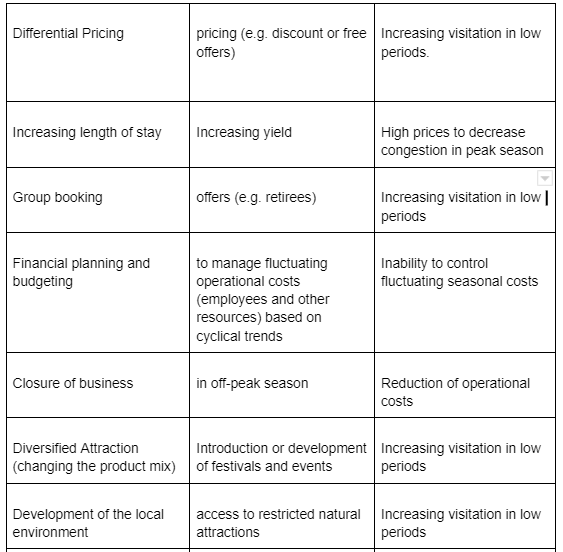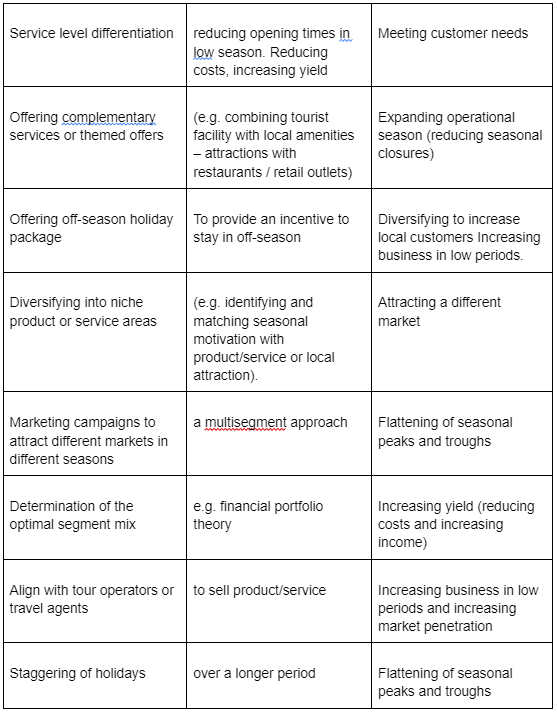
Responding to seasonality
There are similarities with both requirements, in that seasonality causes the fluctuation in tourists and visitor numbers to a destination. Therefore, some destinations at certain times have more tourists and visitors than they are able to accommodate, while at other times, there are too few tourists and visitors to the region. There are many strategies that are used to address the effects of seasonality. These include pricing strategies, diversifying the attraction, market diversification and seeking assistance from the government and industry bodies. Increasing the length of the tourist season and modifying the timing to school holidays are other strategies. At enterprise level, additional strategies include the recruitment of temporary staff. In today’s environment, such decision making would need to include and consider social and environmental factors in addition to economic ones.
Natural seasonality relates to temporal variations in natural phenomena (for example, rainfall, sunlight, temperature, snowfall) of which the implications for certain forms of tourism demand are easily understood. For example, water-orientated tourism activities require a warm temperature whilst snow skiing requires low temperatures and an abundance of snow. Institutionalised seasonality is more complex as it is based on human behaviour and consumer decision making (e.g. deciding on the timing of holidays) now alongside the new variables of covid country entry requirements.
With regard to the spatial issue, the generating area (i.e. place of visitor origin and market demand), various changes in natural phenomena influence visitors’ travel decisions. For instance, most people choose to travel in warm, dry seasons, hence the popularity of summer vacations. Religious, cultural and social factors also dictate when people travel, with one or more of these dimensions often determining the timing of holidays.
Other causes of seasonality in tourism demand are institutional. Institutional seasonality is primarily linked to the following three factors: holidays (school/university and public/religious) and the availability of leisure time; travel habits and motivations (which are affected by changing tastes, social pressure and fashion), and the hosting and timing of events. These events may be leisure or business focused and either major or minor.
Seasonality is concerned with the patterns that are stable and well-established rather than occasional irregularities. As there is an element of predictability associated with seasonality it is possible for managers to anticipate many of its impacts and to implement strategies to adjust to any negative effects.
Strategies for addressing seasonality impacts include:


A better understanding of market segmentation and the motivations of tourists can assist in the development of a product or marketing approach that will encourage greater visitation during the low season. As the causes of seasonality vary from location to location, it is the response by managers and tourism agencies to these causes that is the key focus of strategy development.
Examples of how attractions have adopted some of these strategies include the introduction of restaurants to make a seasonal attraction a year-round attraction. Introduction of package tours for the luxury market possibly including chauffeur-driven tours and behind the scene tours. With regard to pricing strategies, some may find little value in addressing seasonal issues with price variations as it can be seen as cheapening the product. The offer of ‘specials’ is a more acceptable practice.
Whether seasonality does have negative effects might also depend on the presence/absence of other moderator variables, such as the location of a business, or personal characteristics of the operator and the tourists. Such considerations are directly relevant to ‘good practice’. For instance, not all potential tourists are affected by seasonal restrictions on travel, and effective operators can develop products to attract such people. Price cutting and discounting by itself is likely to have negative rather than positive influences and would not constitute ‘good practice’. It is apparent that small changes can have major effects on overcoming negative seasonal influences, such as using smaller boats on a river with lowered water levels.
For a destination in a remote location, seasonality can cause an under-utilisation of resources when visitor numbers are low and an over-increased demand for resources when too many visitors arrive in a short space of time. To address under-utilisation, strategies can be used to attract more visitors, such as events and festivals, promotion of destinations through advertising and incentives to travel by creating and developing new attractions for that location. For the tourism operator, seasonality is perceived as part of their business environment. Where climatic conditions, for example river levels and drought, are related to their business operations, it is accepted that their core business will operate for part of the year. For other parts of the year, other forms of income are relied upon through the offer of another product or service, or the operator may close their business completely until the next season. The successful operators are highly innovative and resourceful in what they can offer. In addition, the marketing of their business can vary to target different markets to address the effects of seasonality. Seasonality presents a number of issues that require special attention and strategies. The areas of greatest concern in relation to the impact of seasonality are:
• The ability of tourism enterprises to individually overcome the problems associated with large swings in seasonal demand;
• The ability of the local destination to provide infrastructure to handle the substantial swings in demand; and
• The desire for collaboration between tourism enterprises with destination, state agencies and partners
The decision to adopt any strategy is a decision that each owner or manager has to make. As with decision making, the more information that can be obtained, the more informed the decision will be. In the past, most decisions made about seasonality were based on economic reasons. Nowadays, there is an expectation that other factors need to be considered, including social and environmental factors.
Seasonality and its related issues are not new to the industry. However, at this time, the tourism environment is not identical to that of a decade ago. Communication technologies have improved and transportation infrastructure has been developed to reduce travel time. Destinations and enterprises are reliant on technology. Both advertising and promotion of a region to an international audience can be done cost effectively. Web pages, text messages and bulk e-mails can convey information to potential tourists of the future. Technology is used to manage the information in a business to provide immediate statistics and results to inform the decision making process. This includes providing information that can be used for monitoring and determining differential pricing strategies. With the availability of improved performance monitoring tools there is greater possibility for enterprises to operate efficient businesses with their just-in-time pricing strategies and other just-in-time inventory coordination.
What is essential, is the need to deploy these new strategies immediately and without any convoluted processes. Technology must support and streamline the business, not strangulate by delaying responses to market demands, trends and global pandemics!
In summary, while seasonality is not a new concept and has been extensively researched in the past, it is not a static concept. New factors such as technology, social change and market expectations impact on the management of seasonality. Hence, current and future plans and strategies should include the changing needs of the tourist alongside the introduction of technology solutions that easily enable:
- The creation of multiple seating plans / capacity plans
- Sales via trade partners and tour operator third parties
- The increase / reduction of capacity
- Stop / freeze sales – either in entirety or at channel, product level
- The introduction / pausing / removal of promotions and other pricing strategies
- Forecasting of sales via various channels
- The combination of product to sell with other own products or third party supplied products